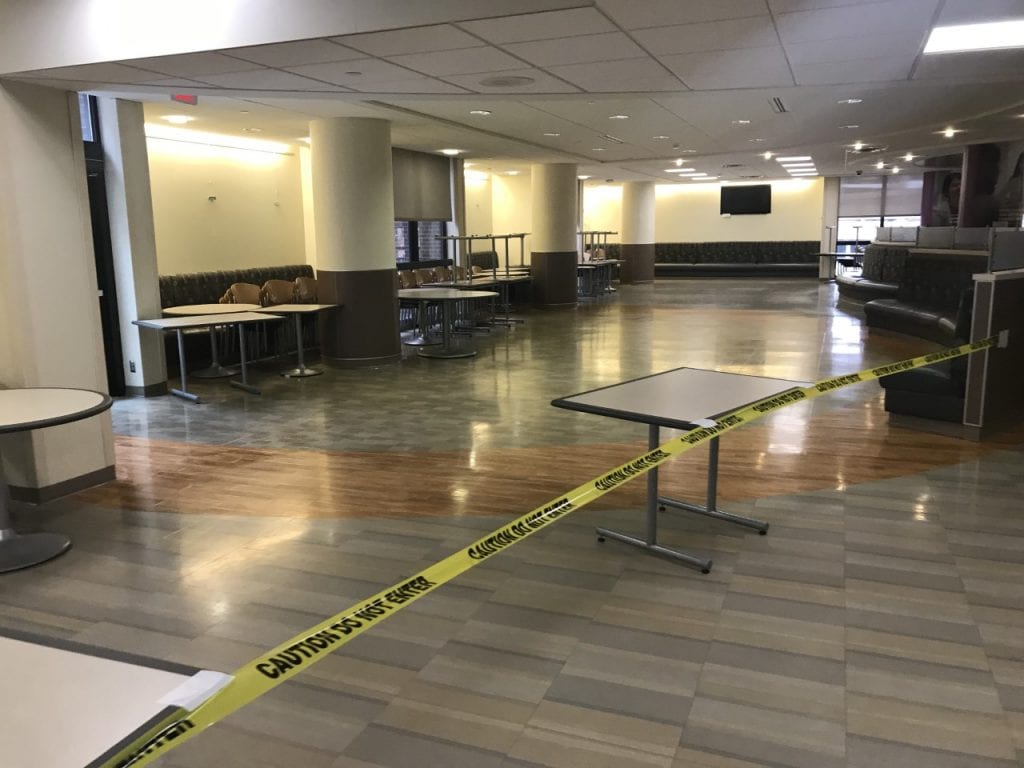So how exactly does one practice social distancing in a hospital?
We are struggling with how to be present for each other and for our patients all while keeping our distance. Those two priorities are sometimes – but not always – mutually exclusive. Being present is literally one of the tenets of person-centered care while keeping six feet apart is literally one of the tenets of social distancing.
Make no mistake, social distancing is necessary and we can do it. To prove it to you, check out our cafeteria at Hennepin Healthcare in this picture:
 Yup, we moved out all the tables to ensure we don’t get too close. Oh, we still stop and greet each other in the hallways, but do so from a reasonable 6 feet apart. Most meetings are by video or phone which is a mixed blessing: good becaues meetings are shorter and more to the point but bad because there is something lost when colleagues can’t see each other or laugh together or have a back-and-forth exchange of ideas. And coffee shops and gift shops are closed. The hallways in the areas of the hospital not directly involved in patient care seem oddly quiet.
Yup, we moved out all the tables to ensure we don’t get too close. Oh, we still stop and greet each other in the hallways, but do so from a reasonable 6 feet apart. Most meetings are by video or phone which is a mixed blessing: good becaues meetings are shorter and more to the point but bad because there is something lost when colleagues can’t see each other or laugh together or have a back-and-forth exchange of ideas. And coffee shops and gift shops are closed. The hallways in the areas of the hospital not directly involved in patient care seem oddly quiet.
So like you at home, we do our best to be present while being far apart.
But what about our patients? The hallways on the patient care floors are still buzzing with the usual activities of patient care. But with patients, how does one practice social distancing? This one is way harder. Masks make it harder to read the face of people, for instance. It is hard enough to give hard and potentially scary news to a patient but even harder when you are wearing a surgical mask and gown and standing across the room.
How about human touch, that most basic part of being a doctor or nurse? If I’m not going to gain any meaningul knowledge that will help you by listening to your chest with my stethoscope, I probably shouldn’t take the risk and I should not touch you at all.
Perhaps hardest of all and the aspect of this COVID-19 pandemic that I can’t get my head and heart around is the restrictions on visitors when someone is critically ill. Our hospital has rightfully limited all visitors to just one at at time to prevent transmission of COVID-19. It is absolutely the right thing to do to protect as many patients and visitors and staff as possible. But some hospitals in the US have limited visitors to zero and we may get to that point as well. We have some extreme end-of-life compassionate care exceptions, but even those exceptions will be less frequent if this pandemic worsens.
There was a piece in the New York Times, called “I’m on the Front Lines. I Have No Plans for This.” It is written by a critical care doctor, Dr. Daniela Lamas, at Brigham and Women’s Hospital in Boston. This is a US hospital. I have friends who are doctors there. This isn’t some far off hospital in another country. This is in one of our country’s premier hospitals. I encourage you to read what Dr. Lamas writes about the real possibility of a “medical solitary confinement” in which patients in COVID-19 wards may be dying alone.
I doubt I’ll ever truly come to accept the possibility that people will be alone while critically ill. I never want to see that. So that is why we practice, and you should practice, social distancing.
Thanks for checking in with this free-form, stream-of-consciousness diary from a pandemic. I’ll write more in a couple days.
David
